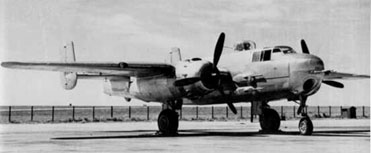NA-98X "Super Strafer"
History
The progression of the B-25 to the NA-98X is a very natural one. Originally, North American wanted to build the B-25 with Pratt & Whitney R-2800 engines. These were not made available, and the reliable Wright engines were used. By 1944, many B-25s were being field modified by the addition of more .50 caliber guns. Side blister packs were being retrofitted onto aircraft that weren't manufactured with them. The 75mm cannon was commonly removed and replaced with .50 guns as well. Improving the performance of the B-25 could also serve as a low cost alternative to the expensive Douglas A-26B. At some point, this aircraft was destined to be built.
The NA-98X was designed to get the most performance out of the existing B-25 platform. To that end, B-25H-5-NA SN 43-4405 was modified. The wing tips were squared off allowing for an increase in the aileron surface area. A new low drag turret canopy was developed. The 2,000 hp Pratt & Whitney engines boosted the power significantly. They were also heavier, increasing the weight. A known issue with the B-25 was excessive bending moments in the wings in extreme conditions. Knowing the increased power and aileron area would allow the NA-98X to easily fly with excessive stresses, the NA-98X was fitted with larger rivets in the leading edge skins to account for this problem. During testing, both the maximum speed and acceleration would be restricted to minimize the stress on the wings.
On March 31, 1944, North American test pilot Joe Barton made the first test flight in the NA-98X. He reported a higher speed, acceleration, reduced vibration, and a significantly improved roll rate. The performance was clearly improved over the previous B-25 models. Over the next 25 days, the NA-98X would be flown by many test pilots. Chief test pilot Ed Virgin, army pilots Major Otto McIver, Captains Fountain and McFadden and Squadron Leader Hartford of the RAF would all fly the NA-98X. Her last test pilot was Major Perry Ritchie of the Air Corps at Wright Field.
Major Ritchie and First Lieutenant Winton Wey were to conduct testing of the new aircraft for the Army Air Force. Major Ritchie was not shy about expressing his pleasure with the new aircraft. At the end of each day's testing, he would complete a high speed, low level pass over the flight ramp, followed by a steep spiral pull up. The North American structural engineers emphasized the airplane was under strict airspeed and acceleration restrictions that were indeed justified. Major Ritchie chose to ignore that warning. As his third day of testing was finishing up, Major Ritchie once again started his high speed, low altitude pass. As he reached the flight line and North American's final assembly area, he once again pulled up hard. This time however, at about 200 feet the outer wing panels separated. They flew back into the tail shearing it from the plane. The plane crashed, instantly killing both Major Ritchie and First Lieutenant Winton Wey.
The NA-98X was completely destroyed. An investigation into the cause of the crash found a deep buckle on the top surface of the right wing panel. It is believed that this failure was not the cause of the crash, but the pilot's reaction to this failure was. It should be noted here that the increased power and improved handling of the NA-98X made it easy to fly outside the structural limits of the wings. This would necessarily have warranted some sort of modification of the wing structure to ensure the safety both the aircraft and crew. Whether this modification would have negated the benefits of the improved design or increased the cost to that of the Douglas A-26B is up for speculation. After the crash, the NA-98X program was halted.
NA-98X Specs |
- Model: NA-98X
- Total Produced: 1 (modified from a B-25H-5-NA)
- Manufacturing Plant: Inglewood, California
- First Test Flight: March 31, 1944
- First Flight Crew: Joe Barton
- Engines: Pratt & Whitney R-2800-51
- Carburetors: Bendix Stromberg
- Fuel Capacity:
- 2 forward wing cells, total 368 gallons
- 2 rear wing cells, total 302 gallons
- 2 wing auxiliary cells, total 304 gallons
- 2 side waist ferry tanks, total 125 gallons
- Droppable bomb bay tank 335 gallons
- 1 fixed ferry tank 585 gallons
- Armament:
- 75mm cannon with 21 rounds
- 4 .50 caliber fixed guns in nose with 1600 rounds
- 2 .50 caliber guns in top turret with 800 rounds
- 2 .50 caliber guns at waist station with 400 rounds
- 2 .50 caliber guns in tail turret with 1200 rounds
- Armor Protection:
- 3/8 inch behind pilots
- Forward of instrument panel
- Forward of cannoneer's station
- Bulkhead aft of turrets
- Around ammunition rack
- Plate below windshield
- External flak plate on left side
- 3/8 inch plate aft of tail gunner
- Weights:
- Gross: 34,000 lbs.
- Speed (Max): 325 mph
- Service Ceiling: 23,800 ft
- Range: Unknown
- Crew:
- Pilot, navigator/cannoneer, engineer/gunner, radio operator/gunner, tail gunner
- Production by year:
- 1944: 1
- First Airplane Accepted: N/A
- Last Airplane Accepted: N/A
| Model | NAA Contract | SN | NAA # | # Produced |
|---|---|---|---|---|
| NA-98X | NA-98 | 43-4406 | 98-21407 | 1 |
- NAA Contract:
- N/A
- Major Visual Production Block Changes:
- Single production block
- Notable Aircraft:




